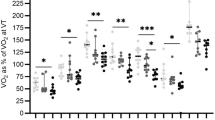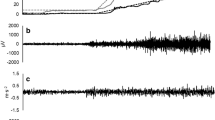Summary
Isometric muscle strength of the handgrip and of trunk flexion and extension, and isokinetic torque of elbow and knee flexion and knee extension were assessed in a random sample of 8 and 13 year old Swedish children. The results were compared with respect to sex and age in absolute terms and relative to weight, height2 and estimates of lean body mass and cross-sectional muscle area. Daily physical activity was also estimated. The muscle strength variables were in general found to be very similar in the 8 year old boys and girls. In the 13 year old group the boys were generally stronger than the girls, in both absolute and relative terms, except for similar torque values during knee extension. The absolute and relative muscle strength and torque values were higher in the older than in the younger children, with the exception of trunk strength per unit of body weight and of lean body mass, which were similar in boys of both ages and significantly lower in the older than in the younger girls. No significant correlation was found between the estimates of physical activity and isometric and isokinetic muscle strength and torque.
Similar content being viewed by others
References
Asmussen E (1973) Growth in muscular strength and power. In: Rarick GL (ed) Physical activity (Human growth and development). Academic Press, London, pp 60–79
Asmussen E, Heeböll-Nielsen K (1955) A dimensional analysis of physical performance and growth in boys. J Appl Physiol 6:585–592
Bowman OJ, Katz B (1984) Hand strength and prone extension in right-dominant, 6 to 9 year olds. Am J Occup Ther 38:367–376
Bäcklund L, Nordgren L (1968) A new method for testing isometric muscle strength under standardized conditions. Scand J Clin Lab Invest 21:33–41
Carron AV, Bailey DA (1974) Strength development in boys from 10 through 16 years. Monographs of the Society for research in child development, serial no. 157, no. 4, pp 37
Davies CTM, White MJ, Young K (1983) Muscle function in children. Eur J Appl Physiol 52:111–114
Eriksson M, Johansson K, Nordgren B, Nordesjö L-O, Borges O (1982) Evaluation of a dynamometer for measurement of isometric and isokinetic torques. Ups J Med Sci 87:223–233
Gilliam ThB, Villanacci JF, Freedson PS, Sady SP (1979) Isokinetic torque in boys and girls ages 7 to 13: effect of age, height, and weight. Res Quart 50:599–609
Gurney JM, Jeliffe DB (1973) Arm anthropometry in nutritional assessments: Nomogram for rapid calculation of muscle circumference and cross-sectional and fat areas. Am J Clin Nutr 26:912–915
Hedberg G, Jansson E (1976) Skeletal muscle fibre distribution, capacity and interest in different physical activities among students in High School. Pedagogiska rapporter, Umeå (in Swedish)
Heeböll-Nielsen K (1982) Muscle strength of boys and girls, 1981 compared to 1956. Scand J Sports Sci 4:37–43
Holmes JR, Alderink GJ (1984) Isokinetic strength characteristics of the quadriceps femoris and hamstring muscles in high school students. Physiol Ther 64:914–918
Ikai M, Fukunaga T (1968) Calculation of muscle strength per unit cross-sectional area of human muscle by means of ultrasonic measurement. Int Z Angew Physiol Einschl Arbeitsphysiol 26:26–32
Kemper HCG, Verschuur R (1985) Motor performance tests. In: Kemper HCG (ed) Growth, health and fitness of teenagers (medicine and sport science, vol 20). Karger, Basel, pp 88–95
Lange Andersen K, Rutenfranz J, Masironi R, Seliger V (1978) Habitual physical activity and health. WHO regional Publ, Eur Ser No 6 (WHO, Copenhagen)
Lamphiear DE, Montoye HJ (1976) Muscular strength and body size. Hum Biol 48:147–160
Larsson L, Grimby G, Karlsson J (1979) Muscle strength and speed of movement in relation to age and muscle morphology. J Appl Physiol 46:451–456
Metheny E (1941) The present status of strength testing for children of elementary school and preschool age. Res Quart 12:115–130
Miyashita M, Kanehisa H (1979) Dynamic peak torque related to age, sex, and performance. Res Quart 50:249–255
Molnar GE, Alexander J (1974) Development of quantitative standards for muscle strength in children. Arch Physiol Med Rehab 55:490–493
Molnar G, Alexander J, Gutfeld N (1979) Reliability of quantitative strength measurements in children. Arch Physiol Med Rehab 60:218–221
Newman DG, Pearn J, Barnes A, Young CM, Kehoe M, Newman J (1984) Norms for handgrip strength. Arch Dis Child 59:453–459
Parizková J (1961) Total body fat and skinfold thickness in children. Metabolism 10:794–807
Saris WHM, Binkhorst RA (1977) The use of pedometer and actometer in studying daily physical activity in man: Part II: Validity of pedometer and actometer measuring daily physical activity. Eur J Appl Physiol 37:229–235
Sunnegårdh J, Bratteby L-E (1987) Maximal oxygen uptake, anthropometry and physical activity in a randomly selected sample of 8 and 13 year old children in Sweden. Eur J Appl Physiol 56:266–272
Sunnegårdh J, Bratteby L-E, Sjölin S, Hagman U, Hoffstedt A (1985) The relation between physical activity and energy intake in 8- and 13-year-old children in Sweden. In: Binkhorst RA, Kemper HCG, Saris WHM (eds). Children and exercise XI [Int Ser Sport Sci, vol. 15]. Human Kinetics Publishers, Inc., Champaign, III, pp 183–193
Weiner JS, Louire JA (1969) Human Biology, a guide to field methods. International Biological Programme. Blackwell Scientific Publications, Oxford, Edinburgh
Author information
Authors and Affiliations
Rights and permissions
About this article
Cite this article
Sunnegårdh, J., Bratteby, L.E., Nordesjö, L.O. et al. Isometric and isokinetic muscle strength, anthropometry and physical activity in 8 and 13 year old Swedish children. Europ. J. Appl. Physiol. 58, 291–297 (1988). https://doi.org/10.1007/BF00417265
Accepted:
Issue Date:
DOI: https://doi.org/10.1007/BF00417265




